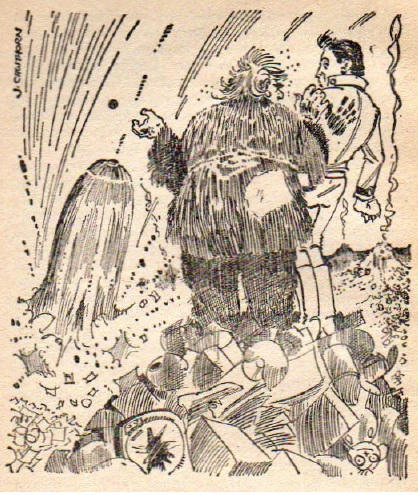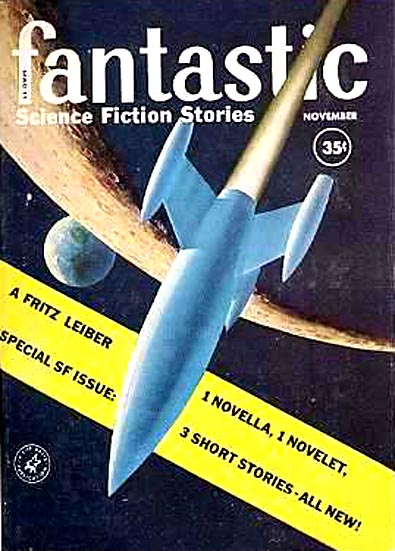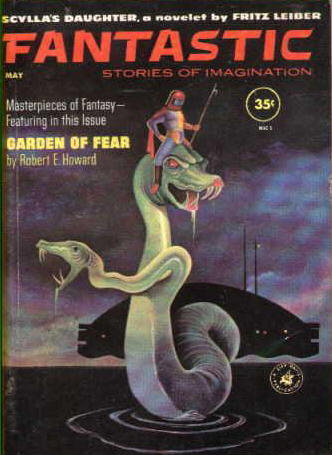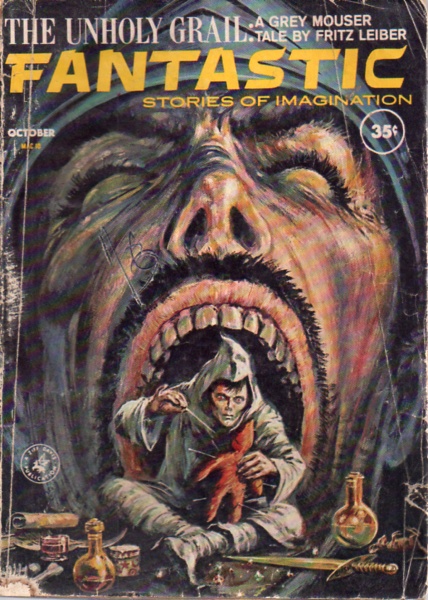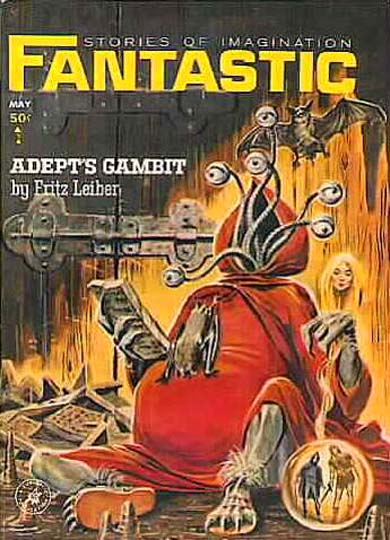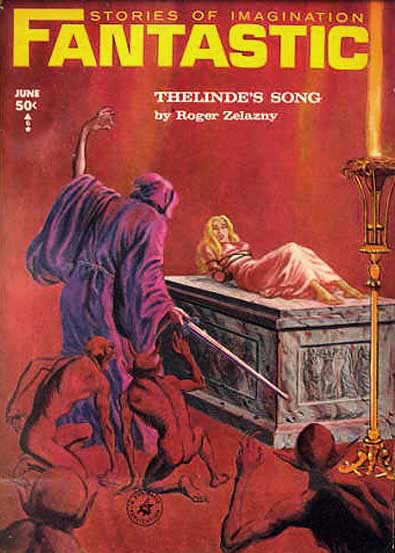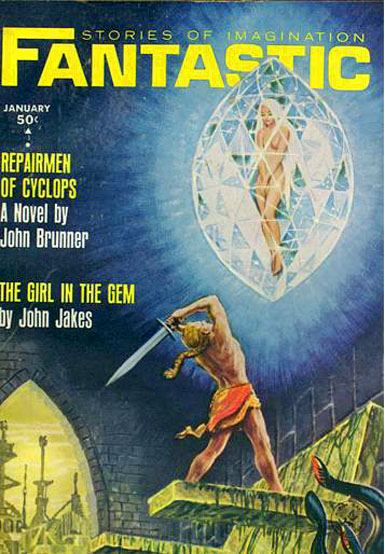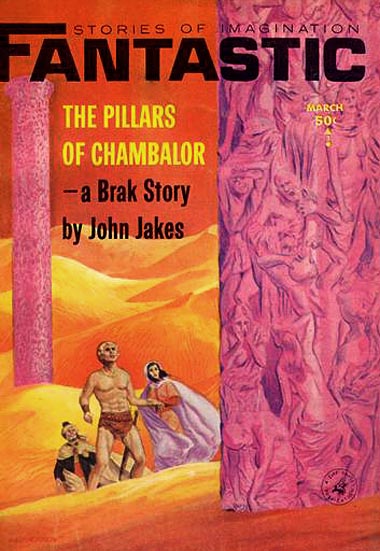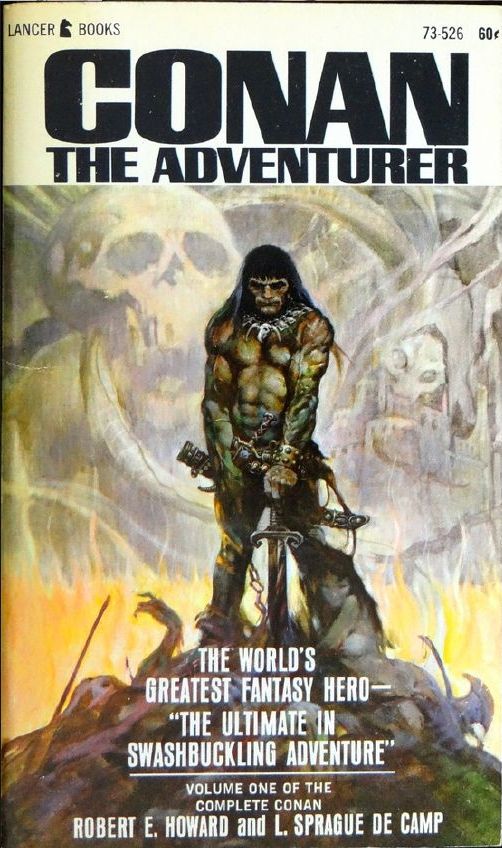The Gate of Time by Philip Jose Farmer

by Mx. Kris Vyas-Myall
SF books are like buses, you wait forever for one you want to pick up, then many come along at once. From the weird spy drama of Kingsley Amis’ Anti-Death League, to Andre Norton’s space fantasy The Moon of Three Rings. From Brian W. Aldiss’ collection The Saliva Tree & Other Growths, to expansions from Disch and Zelazny. However, our esteemed editor steered me towards Farmer’s new novel, and I am very glad he did.
Down the Path
I am starting to see through lines in the current crop of great SF writers. J. G. Ballard has been doing his cut-up explorations of Inner Space. Harry Harrison is involved in grim satires of conservative issues. Rosel George Brown has begun writing novels that put her own unique stamp on space adventures. Whilst Roger Zelazny is applying a literary and philosophical twist to the standard scenarios of science fiction and fantasy.
However, Philip Jose Farmer is harder to pin down. What connects the fabulous tales of Riverworld, the sword & wonder novels of Robert Wolff, and the religious exploration of Night of Light? Perhaps his latest novel,The Gate of Time, holds the key?
Through the Doorway

One thing that needs to be noted before I start. This cover bears no relation to the book itself, as best as I can tell (except the existence on men and women in the story). Possibly it was originally intended for another novel and reused?
Whatever the case may be, here is the actual plot of Farmer’s work: Lt. Roger Two Hawks is a half-Iroquoian pilot in WW2. He is going on a bombing raid on the oil fields in Ploetsi when his bomber and a German fighter crash land on a strange Earth. In this one there is another war going on between the Prussian-esque Perkunisha and the Anglo-Nordic Blodland, the latter in alliance with Eastern Europe states whose people seem to be Amerinds. Both sides are aware of these strange visitors and want the technology of their planes to tip the tide in the war.
(As an aside, Two Hawks names this world "Earth 2", which is how I will refer to it going forward. As he makes mention of comic books in the text, I am assuming this a reference to the Earth 2 seen in National Comics' Flash and Justice League of America.)
Earth 2 is built on an interesting premise: what if America had remained largely underwater? A lesser writer would probably do something like all of Europe submerged into a conflict of the totalitarian states of England and France, with the brave American outlander teaching the people the true value of democracy and leading them in a revolution, where he becomes the first president of the United States of Europe.
But not Farmer; he thinks things through in much greater detail. He considers how language and culture would change, the Amerind states that would exist in Europe and Asia, the weather patterns from the differing position of the Gulf Stream and much more. As Farmer posits what is missing from the Earth 2 without the Americas, he shows how pivotal the American continent has been to world history in a vast number of ways. In doing so he creates one of his most fleshed out worlds.
Two Hawks avoids being the kind of cliché you might find in, for example, a Mack Reynolds story. He says he is as much a part of mainstream White American culture as he is Iroquoian. And he regularly rejects people’s assumptions of him, such as believing he grew up on a reservation. His knowledge is of mechanics, history and science, not the kind of spiritual and earthy traditional you usually see depicted in Amerind characters.
Whilst, by necessity, large parts of the plot are told through long conversations about the nature of Earth 2 and how it compares to Earth 1 (Two Hawks’ Earth), I never found myself being bogged down. This is a pacey thriller where I was constantly engaged and wanting to know what happened next.
This does lead to my most major issue with the text: the simplicity of plot at times. Once you get past the differences in the world, it is largely a pulpy World War Two adventure. We have Germans (by geography if not ethnicity) who are committing genocidal acts against Eastern European populations and the British fighting them. Two Hawks allies with the British stand ins, not out of some moral sense (he says he doesn’t really think there is that much difference between nations in this world) but instead because he just doesn’t like Germans. At the same time the imported German pilot, Raske, is an opportunistic villain not given any more depth than being a tricky antagonist for Two Hawks.
Farmer would also have us believe history aligns on other Earths. If things are so different, why was there also a First World War where the Perkunishans were defeated? Why does Blodland have Dravidian (Indian) bases? Why are languages so similar between the Earths? The reason just seems to be, “because”.
I don’t want to be overly harsh. There is still a lot to like. I want to also note the framing device, which is used to pull off a final twist to great effect. The only other time I can think of a similar device being used is in Pierre Boulle’s Monkey Planet.
All of this adds up to another fantastic entry in Farmer’s bibliography.
On the Other Side of the Wall
But, to return to my original question: what is it that holds together the disparate threads of Farmers fiction? I think it is the worlds themselves. Earth 2 in The Gate of Time is just as well conceived and memorable as Riverworld or Okeanas.
As such I hope we get more tales in this setting. Whether that be Two Hawks visiting more timelines, or just more of the history of Earth 2.
A solid four stars
Planet of Exile by Ursula K. LeGuin

by Jason Sacks
Imagine a world that has been colonized – but the colonizers have lived on that world so long that their descendents have nearly forgotten their original roots.
And imagine those colonizers have the ability to communicate with each other using a kind of telepathy that always keeps them in contact with each other.
And imagine a world with a sixty-year rotation around its sun, a rotation so slow that seasons take years in our time. In fact, it's a rotation so slow that grown adults have no idea what winter will be like and have never seen snow.
And imagine on that world, there are groups who are at war with each other for the limited resources on that planet. And that the colonizers are caught in the middle of that war.
And finally, imagine an independent local woman and a passionate colonist meet, become fascinated with each other, get married impulsively, and become embroiled in a war.
Sounds like the recipe for a 400-page book, right?
And yet Ursula K. LeGuin creates a whole. compelling, intriguing world in a mere 125 pages in Planet of Exile.

Earlier this year I enthused over LeGuin's debut novel Rocannon's World, praising the author for her strengths in building a complex fictional environment and for bridging the gap between fantasy and science fiction. Planet of Exile builds on those strengths, taking readers to a world that seems vivid on the page, with complex interrelationships, intriguing characters and a background which seems to go back hundreds of years.
LeGuin smartly starts the book by anchoring readers in the experiences of the independent woman, Rolery, who is wandering through a forest at the "last moonphase of autumn" (as LeGuin states it) and is startled by a barefoot runner dashing through the woods towards her native town of Tovar. But Rolery goes the opposite direction, towards the village of the "farborn"; forbidden, mysterious, a place she could scarcely imagine but which holds great fascination for her. In that farborn village, she meets a farborn man named Jacob Agat whose life changes her and changes the city of Tovar.
Planet of Exile is an odd book in part because this relationship feels so insubstantial and unreal. This mismatched couple don't fall in love as much as they fall into admiration, or caring, or simply desperately feel the need for deep companionship. Lesser writers might have created a simple Romeo and Juliet type relationship between Rolery and Agat. But LeGuin's ambitions seem well beyond the obvious cliché and instead she explores more complex ideas like assimilation, battles for resources, and the complex struggles to thrive in an alien environment.
If LeGuin merely touches upon those ideas rather than dwells on them, well, blame that on the page length and consider this young author may merely need to grow into fully exploring these concepts.

About half this book is taken up with the battles between the barbaric nomads, the Gaal, and the people of Tevara. The battles are often seen as slivers, in fragments, through the eyes of the different characters of this book rather than in omniscient form. As such, the events feel extraordinarily vivid. I was deeply struck by a scene of the invading Gaal force and their supporters so large they filled one large valley from end to end, with more of them coming. And a rooftop battle reflected a wonderful combination of Errol Flynn style derring-do and alien landscapes.
All of this thoughtful inventiveness makes for a tremendously entertaining and tremendously dense read, accentuated by LeGuin's empathetic and often poetic writing which has a fantastic knack for bringing alien situations to life. There's a kind of ecstatic forward-hurtling beauty in a paragraph like this one that had me entranced:
She the stranger, the foreigner, of alien blood and mind, did not share his power or his conscience or his knowledge or his exile. She shared nothing at all with him, but had met him and joined with him wholly and immediately across the gulf of thier great difference: as if it were the difference, the alienness between them, that let them meet, and that in joining together, freed them.
Ultimately, Planet of Exile is a novel of aspirations not quite met. War is fought and attacks repelled at great cost. Relationships start but never reach an emotionally satisfying happy ending. Many complex questions are raised but never quite answered. And the character of Rolery is intriguing in her independence and agency, in her impulsive decisions and her steadfast curiousity, but she never becomes the three-dimensional character LeGuin obviously saw in her mind.
I concluded my review of Ms. LeGuin's earlier novel with a wish to read more novels that would realize the promise of this exciting new author. I am left now in a similar position, albeit perhaps closer to that realization.
3.5 stars
[Note: the flip side of this Double, Mankind Under the Leash, is an expansion of the 1965 story White Fang Goes Dingo (Ed.)]

![[October 14, 1966] Alien Worlds in Precise Detail (Galactoscope)](https://galacticjourney.org/wp-content/uploads/2021/10/661014cover-672x372.jpg)

![[October 12, 1966] Inside Out (<i>Star Trek's</i> "The Enemy Within")](https://galacticjourney.org/wp-content/uploads/2021/10/661012title-672x372.jpg)


![[October 10, 1966] Let's Take A Trip (November 1966 <i>Worlds of Tomorrow</i>)](https://galacticjourney.org/wp-content/uploads/2021/10/Worlds_of_Tomorrow_v04n02_1966-11_0000-2-672x313.jpg)

















![[October 8, 1966] Martial Law in San Francisco (Hunters Point riots)](https://galacticjourney.org/wp-content/uploads/2021/10/Mayor_Shelley_at_Potrero_Police_Station-672x372.jpg)


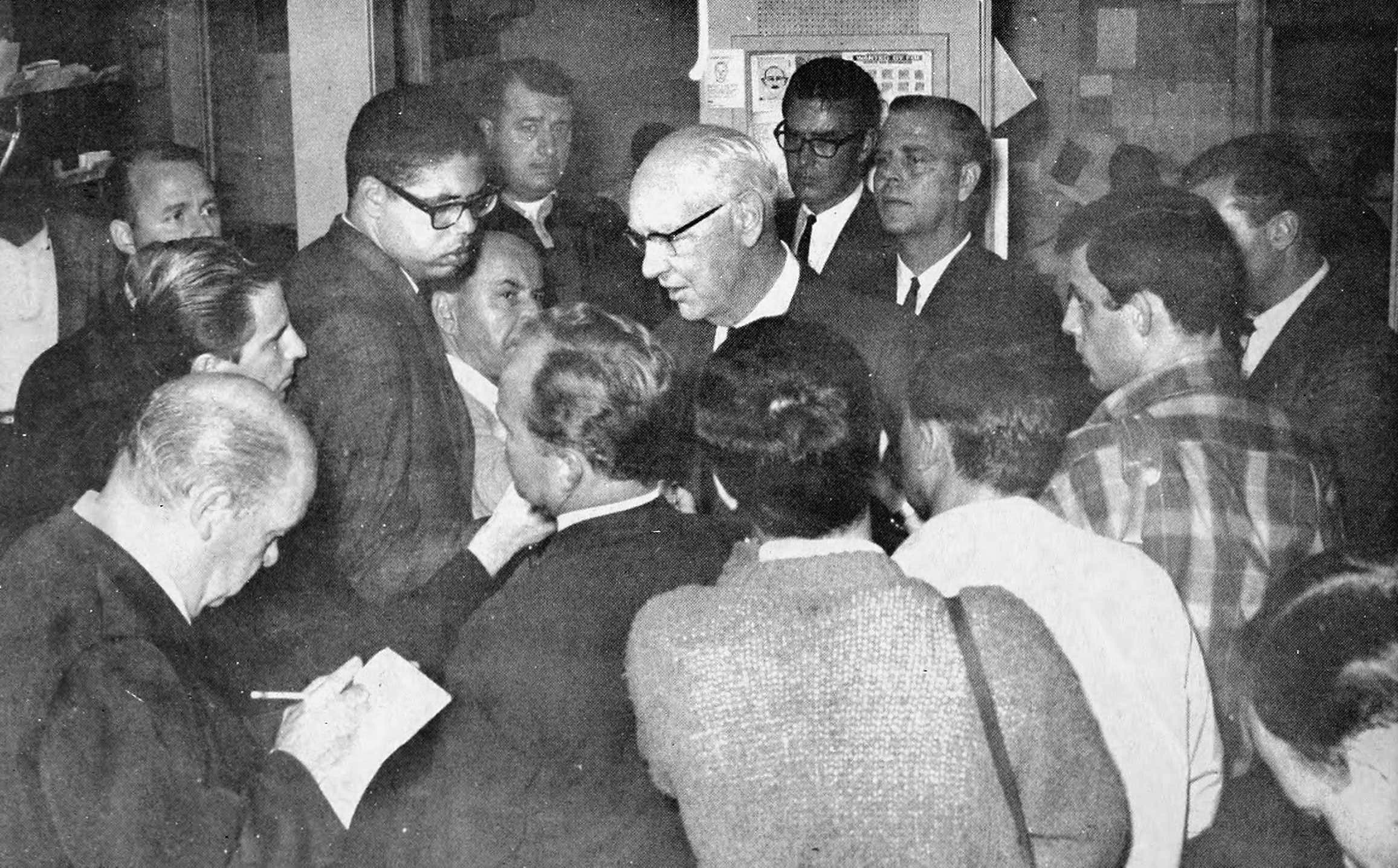
 The National Guard Lands on City Hall
The National Guard Lands on City Hall 
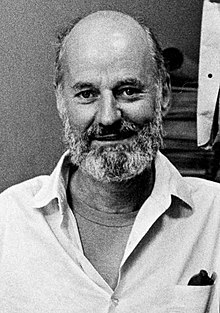
![[October 6, 1966] One Trek, neat (<i>The Naked Time</i>)](https://galacticjourney.org/wp-content/uploads/2021/10/661006title-672x372.jpg)



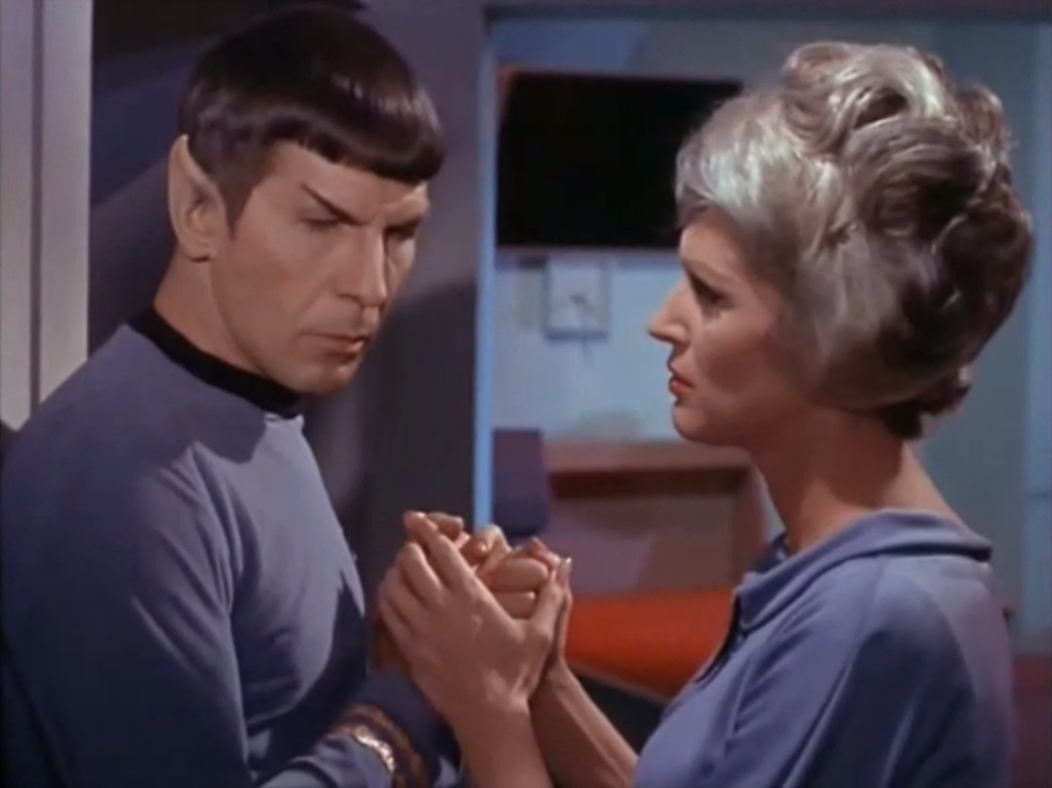
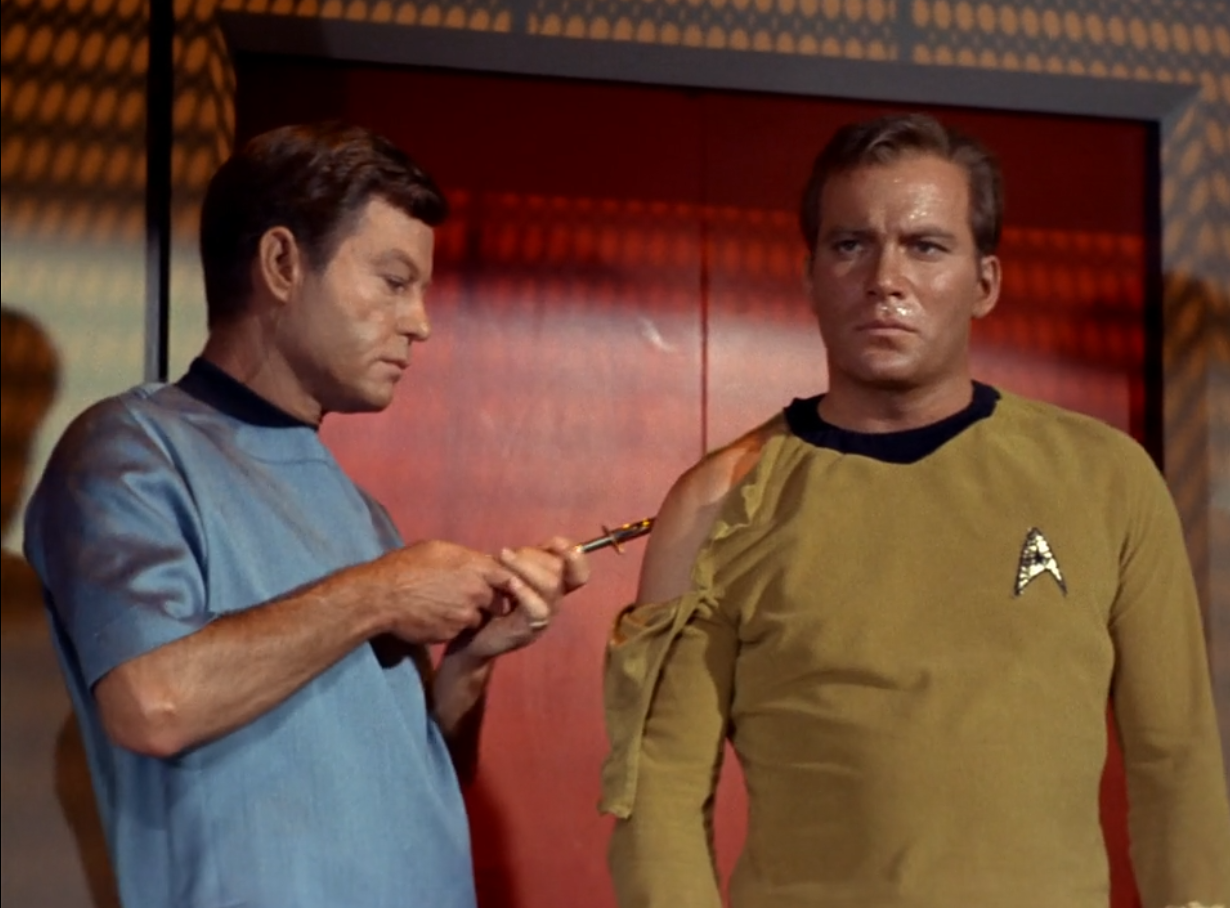









![[October 4, 1966] The Real Treasure Was The Friends We Made Along The Way (<i>Doctor Who</i>: The Smugglers)](https://galacticjourney.org/wp-content/uploads/2021/10/6601004kidnap-672x372.jpg)


![[October 2, 1966] At Heart (November 1966 <i>IF</i>)](https://galacticjourney.org/wp-content/uploads/2021/09/IF-1966-10-Cover-646x372.jpg)



![[September 30, 1966] Return to Base (October 1966 <i>Analog</i>)](https://galacticjourney.org/wp-content/uploads/2021/09/660930cover-672x372.jpg)









![[September 28, 1966] Garbage and Aliens (October 1966 <i>New Worlds</i> and <i>SF Impulse</i>)](https://galacticjourney.org/wp-content/uploads/2021/09/New-Worlds-SF-Impulse-Sept-1966-672x372.jpg)


